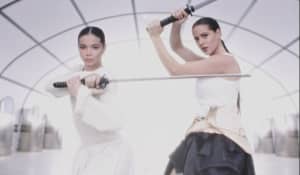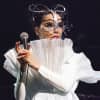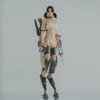Björk put out the best music videos of her career in 2017
“The Gate” director Andrew Thomas Huang articulates a unified theory of the Björk visual universe.
In the videos accompanying her new album Utopia, Björk edges closer to realizing a world she’s had in mind since she put out her very first videos. Few artists use videos like she does, as a deepening of the music rather than just an accessory to it, and even fewer suspend the same themes in their visual work over careers spanning multiple decades. From Michel Gondry's 1993 video for "Human Behavior" to Jesse Kanda's recent "Arisen My Senses" short, Björk's videos have situated the human body as a site of radical play and experimentation. In both videos, she appears neither fully human nor entirely animal; like she does in most of her work, she complicates the line between human and not-human, and sees the softening of that boundary as a potential route to liberation.
Visual agnosticism about the line between the body and its environment has often been employed toward horror, as with the grotesque practicals used in films by David Cronenberg, John Carpenter, and David Lynch. As unusual as the depictions of bodies may be in Björk videos — she's a willing host to a variety of slimes in "Hidden Place," and her face animates two robots who make out with each other in "All is Full of Love" — they never steer viewers toward revulsion. Instead, they invite the viewer to consider the transcendence of a disrupted body, to see it not as a desecration of the human form but as an evolution. It's a feminine (and queer) way of looking at the body. If the patriarchal gaze renders the body in opposition to its environment, man as nature's conqueror, then a feminine gaze might suggest there's no difference between the body and its surroundings, the human and the earth that produced it.
Speaking from his home in Los Angeles, filmmaker Andrew Thomas Huang, who directed the recent Utopia video "The Gate," spoke to the longstanding themes that resonate throughout Björk's visual universe. "Björk has always treated her body as a map or a landscape," he tells me. "It's kind of like finding new imagination in the way a body can be represented. Body horror is often the first thing we try and grasp because that is one of the few genres where bodies are pried apart and turned into plastic things you can manipulate. Björk does it in a way that's fresh and positive and hopeful, which I think is rare and very queer. And when I say queer, I just mean that there's a sexual fluidity and a sexual possibility with the way she presents her own body. It's always alien and new and challenging."
In "The Gate" video, Björk and a human figure suggested by metallic tendrils pass a glowing, throbbing prism back and forth through the air. It's one of her most moving videos, a spiritual sequel to Chris Cunningham's iconic 1999 visual for "All is Full of Love" but rendered with less literalism. Where Cunningham's robots looked like technological products on the assembly line (there's a logo on them and everything), Huang's figures leave themselves open to interpretation. They're humanoid, but not quite people; concrete, but not entirely material. "'The Gate' is designed to show bodies in a fractured, prismatic way, but also to show bodies relating to each other in a transcendent, spiritual way," Huang says. "When you think about it, chakras and Vedic spiritualism are essentially all about breaking the body into different chromatic wavelengths. A prism is something that refracts light, and these bodies too should be refracted into different colors."
“It’s always alien and new and challenging.” — Andrew Thomas Huang
Jesse Kanda's new video for "Arisen My Senses" similarly splits Björk up into multiple parts. In the video's first sequence, you see Björk in a glowing cocoon nestled next to a giant mouth with two tongues. The mouth looks like her mouth; she's simultaneously singing from her own mouth inside the cocoon and opening her mouth outside it. Then she emerges as a leopard moth, apparently on the same planet she can be seen playing the flute at the very beginning of "The Gate." Arca, Utopia's co-producer and Kanda's frequent collaborator, appears, and the two figures bow to each other. The space they're in feels like a paradise only slightly out of reach of our own reality, a universe humanity could access if it could only figure out how to be born.
Both "The Gate" and "Arisen My Senses" grapple with ideas Björk has always carried in her work, but with unprecedented nuance and power. Bodies become more than bodies, and the world becomes more than the world. It's easy enough to picture dystopia on a daily basis; you don't even need much imagination, just look at the news. Björk's visual utopias offer relief from the mundane, but they also offer new ways of thinking about the body's relationship to the world around it. They're escape pods from the toxic status quo, test universes in which we might imagine living in an environment we're not actively destroying. Few artists have rendered such a clear image of what might be called paradise.


